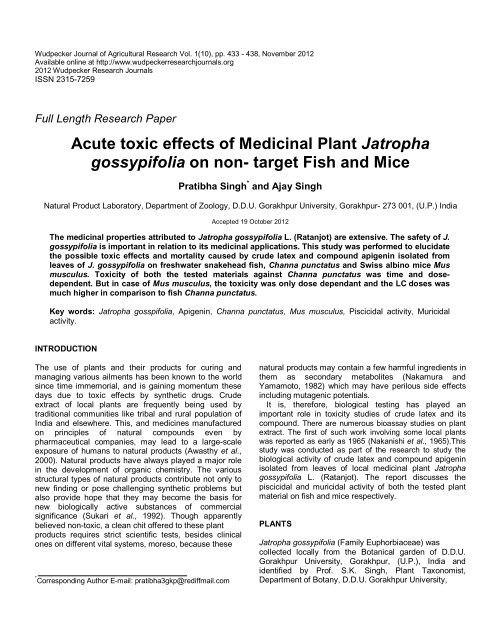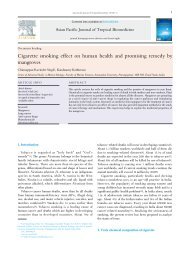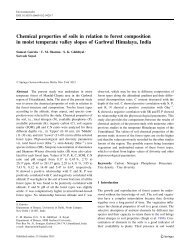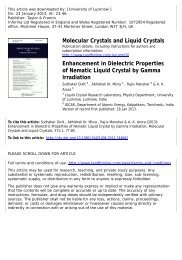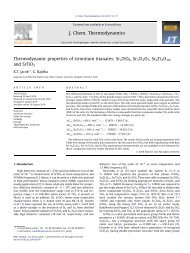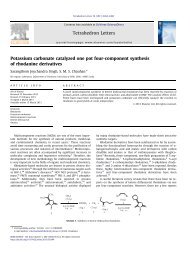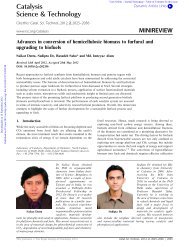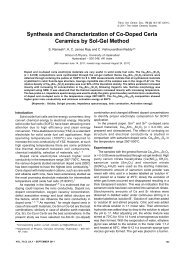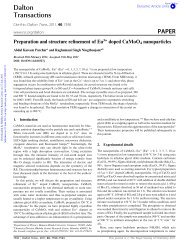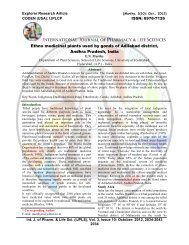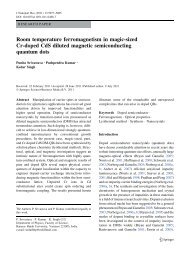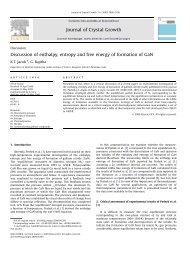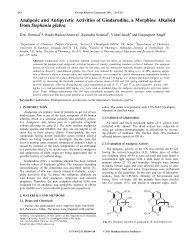Acute toxic effects of Medicinal Plant Jatropha gossypifolia on non ...
Acute toxic effects of Medicinal Plant Jatropha gossypifolia on non ...
Acute toxic effects of Medicinal Plant Jatropha gossypifolia on non ...
Create successful ePaper yourself
Turn your PDF publications into a flip-book with our unique Google optimized e-Paper software.
Wudpecker Journal <str<strong>on</strong>g>of</str<strong>on</strong>g> Agricultural Research Vol. 1(10), pp. 433 - 438, November 2012Available <strong>on</strong>line at http://www.wudpeckerresearchjournals.org2012 Wudpecker Research JournalsISSN 2315-7259Full Length Research Paper<str<strong>on</strong>g>Acute</str<strong>on</strong>g> <str<strong>on</strong>g>toxic</str<strong>on</strong>g> <str<strong>on</strong>g>effects</str<strong>on</strong>g> <str<strong>on</strong>g>of</str<strong>on</strong>g> <str<strong>on</strong>g>Medicinal</str<strong>on</strong>g> <str<strong>on</strong>g>Plant</str<strong>on</strong>g> <str<strong>on</strong>g>Jatropha</str<strong>on</strong>g><str<strong>on</strong>g>gossypifolia</str<strong>on</strong>g> <strong>on</strong> n<strong>on</strong>- target Fish and MicePratibha Singh * and Ajay SinghNatural Product Laboratory, Department <str<strong>on</strong>g>of</str<strong>on</strong>g> Zoology, D.D.U. Gorakhpur University, Gorakhpur- 273 001, (U.P.) IndiaAccepted 19 October 2012The medicinal properties attributed to <str<strong>on</strong>g>Jatropha</str<strong>on</strong>g> <str<strong>on</strong>g>gossypifolia</str<strong>on</strong>g> L. (Ratanjot) are extensive. The safety <str<strong>on</strong>g>of</str<strong>on</strong>g> J.<str<strong>on</strong>g>gossypifolia</str<strong>on</strong>g> is important in relati<strong>on</strong> to its medicinal applicati<strong>on</strong>s. This study was performed to elucidatethe possible <str<strong>on</strong>g>toxic</str<strong>on</strong>g> <str<strong>on</strong>g>effects</str<strong>on</strong>g> and mortality caused by crude latex and compound apigenin isolated fromleaves <str<strong>on</strong>g>of</str<strong>on</strong>g> J. <str<strong>on</strong>g>gossypifolia</str<strong>on</strong>g> <strong>on</strong> freshwater snakehead fish, Channa punctatus and Swiss albino mice Musmusculus. Toxicity <str<strong>on</strong>g>of</str<strong>on</strong>g> both the tested materials against Channa punctatus was time and dosedependent.But in case <str<strong>on</strong>g>of</str<strong>on</strong>g> Mus musculus, the <str<strong>on</strong>g>toxic</str<strong>on</strong>g>ity was <strong>on</strong>ly dose dependant and the LC doses wasmuch higher in comparis<strong>on</strong> to fish Channa punctatus.Key words: <str<strong>on</strong>g>Jatropha</str<strong>on</strong>g> gosspifolia, Apigenin, Channa punctatus, Mus musculus, Piscicidal activity, Muricidalactivity.INTRODUCTIONThe use <str<strong>on</strong>g>of</str<strong>on</strong>g> plants and their products for curing andmanaging various ailments has been known to the worldsince time immemorial, and is gaining momentum thesedays due to <str<strong>on</strong>g>toxic</str<strong>on</strong>g> <str<strong>on</strong>g>effects</str<strong>on</strong>g> by synthetic drugs. Crudeextract <str<strong>on</strong>g>of</str<strong>on</strong>g> local plants are frequently being used bytraditi<strong>on</strong>al communities like tribal and rural populati<strong>on</strong> <str<strong>on</strong>g>of</str<strong>on</strong>g>India and elsewhere. This, and medicines manufactured<strong>on</strong> principles <str<strong>on</strong>g>of</str<strong>on</strong>g> natural compounds even bypharmaceutical companies, may lead to a large-scaleexposure <str<strong>on</strong>g>of</str<strong>on</strong>g> humans to natural products (Awasthy et al.,2000). Natural products have always played a major rolein the development <str<strong>on</strong>g>of</str<strong>on</strong>g> organic chemistry. The variousstructural types <str<strong>on</strong>g>of</str<strong>on</strong>g> natural products c<strong>on</strong>tribute not <strong>on</strong>ly t<strong>on</strong>ew finding or pose challenging synthetic problems butalso provide hope that they may become the basis fornew biologically active substances <str<strong>on</strong>g>of</str<strong>on</strong>g> commercialsignificance (Sukari et al., 1992). Though apparentlybelieved n<strong>on</strong>-<str<strong>on</strong>g>toxic</str<strong>on</strong>g>, a clean chit <str<strong>on</strong>g>of</str<strong>on</strong>g>fered to these plantproducts requires strict scientific tests, besides clinical<strong>on</strong>es <strong>on</strong> different vital systems, moreso, because these* Corresp<strong>on</strong>ding Author E-mail: pratibha3gkp@rediffmail.comnatural products may c<strong>on</strong>tain a few harmful ingredients inthem as sec<strong>on</strong>dary metabolites (Nakamura andYamamoto, 1982) which may have perilous side <str<strong>on</strong>g>effects</str<strong>on</strong>g>including mutagenic potentials.It is, therefore, biological testing has played animportant role in <str<strong>on</strong>g>toxic</str<strong>on</strong>g>ity studies <str<strong>on</strong>g>of</str<strong>on</strong>g> crude latex and itscompound. There are numerous bioassay studies <strong>on</strong> plantextract. The first <str<strong>on</strong>g>of</str<strong>on</strong>g> such work involving some local plantswas reported as early as 1965 (Nakanishi et al., 1965).Thisstudy was c<strong>on</strong>ducted as part <str<strong>on</strong>g>of</str<strong>on</strong>g> the research to study thebiological activity <str<strong>on</strong>g>of</str<strong>on</strong>g> crude latex and compound apigeninisolated from leaves <str<strong>on</strong>g>of</str<strong>on</strong>g> local medicinal plant <str<strong>on</strong>g>Jatropha</str<strong>on</strong>g><str<strong>on</strong>g>gossypifolia</str<strong>on</strong>g> L. (Ratanjot). The report discusses thepiscicidal and muricidal activity <str<strong>on</strong>g>of</str<strong>on</strong>g> both the tested plantmaterial <strong>on</strong> fish and mice respectively.PLANTS<str<strong>on</strong>g>Jatropha</str<strong>on</strong>g> <str<strong>on</strong>g>gossypifolia</str<strong>on</strong>g> (Family Euphorbiaceae) wascollected locally from the Botanical garden <str<strong>on</strong>g>of</str<strong>on</strong>g> D.D.U.Gorakhpur University, Gorakhpur, (U.P.), India andidentified by Pr<str<strong>on</strong>g>of</str<strong>on</strong>g>. S.K. Singh, <str<strong>on</strong>g>Plant</str<strong>on</strong>g> Tax<strong>on</strong>omist,Department <str<strong>on</strong>g>of</str<strong>on</strong>g> Botany, D.D.U. Gorakhpur University,
Singh and Singh 434Gorakhpur, U.P. (India) where the boucher specimen wasdeposited.Uses in Traditi<strong>on</strong>al Medicine<str<strong>on</strong>g>Jatropha</str<strong>on</strong>g> <str<strong>on</strong>g>gossypifolia</str<strong>on</strong>g> is used in different countries inmany ways. The plant is antibiotic, insecticidal and usedfor toothache and as blood purifier (Balee, 1994). Itpossesses significant anticancer, hepatoprotective andpesticidal activity (Hartwell, 1969; Chatterjee et al., 1980;Panda et al., 2009; Panda et al., 2009). The roots, stems,leaves, seeds, and fruits <str<strong>on</strong>g>of</str<strong>on</strong>g> the plant have been widelyused in traditi<strong>on</strong>al folk medicine in many parts <str<strong>on</strong>g>of</str<strong>on</strong>g> differentcountries. The young stem <str<strong>on</strong>g>of</str<strong>on</strong>g> the plant is used astoothbrush as well as to clean the t<strong>on</strong>gue in the treatmentthrush (Ogundare, 2007). The stem sap stops bleedingand itching <str<strong>on</strong>g>of</str<strong>on</strong>g> cuts and scratches (Labadie et al., 1989;Mort<strong>on</strong>, 1968; Mort<strong>on</strong>, 1980). The stem latex has beenshown to possess coagulant activity and its mechanism<str<strong>on</strong>g>of</str<strong>on</strong>g> acti<strong>on</strong> as haemostatic agent found to be byprecipitati<strong>on</strong> <str<strong>on</strong>g>of</str<strong>on</strong>g> coagulant factors (Oduola et al., 2005).The leaves <str<strong>on</strong>g>of</str<strong>on</strong>g> J. <str<strong>on</strong>g>gossypifolia</str<strong>on</strong>g> are used for intermittentfevers, carbuncles, eczema, itches, and sores <strong>on</strong> thet<strong>on</strong>gues <str<strong>on</strong>g>of</str<strong>on</strong>g> babies, swollen mammae, stomachache, andvenereal disease and as blood purifier (Balee, 1994). Theleaf decocti<strong>on</strong> is used for bathing wounds (woundhealing) (Mort<strong>on</strong>, 1968; Mort<strong>on</strong>, 1981). In SouthernNigeria, the fresh leaf extract applied with crushed leaf byherbalists and local people used to stop bleeding fromskin and nose (Mort<strong>on</strong>, 1981; Omoregbe et al., 1996).The leaf extract has been used as an anticoagulant forbiochemical and haematological analysis (Oduola et al.,2005).From leaves <str<strong>on</strong>g>of</str<strong>on</strong>g> <str<strong>on</strong>g>Jatropha</str<strong>on</strong>g> <str<strong>on</strong>g>gossypifolia</str<strong>on</strong>g>, threeflav<strong>on</strong>oids were isolated viz. apigenin, vitexin andisovitexin (Subramanian et al., 1971). The latex <str<strong>on</strong>g>of</str<strong>on</strong>g> J.<str<strong>on</strong>g>gossypifolia</str<strong>on</strong>g> yeilds the cyclic heptapeptide, cyclogossineA (Horsten et al., 1996) and cyclic octapeptidesCyclogossine B (Auvin-Guette et al., 1997).EXPERIMENTAL MATERIALSExperimental material 1The yellowish milky latex <str<strong>on</strong>g>of</str<strong>on</strong>g> <str<strong>on</strong>g>Jatropha</str<strong>on</strong>g> <str<strong>on</strong>g>gossypifolia</str<strong>on</strong>g> drained into glasstubes by cutting the stem apices. The latex was centrifuged at 1000rpm for 20 minutes to remove the resin. This resin free latexlyophilized at - 40°C, and the lyophilized powder stored for furtheruse. The wet weight <str<strong>on</strong>g>of</str<strong>on</strong>g> <strong>on</strong>e ml latex <str<strong>on</strong>g>of</str<strong>on</strong>g> J. <str<strong>on</strong>g>gossypifolia</str<strong>on</strong>g> was 1.04 gmand dry weight (lyophilized at - 40°C) was 0.140 gm.Experimental material 2Extracti<strong>on</strong> <str<strong>on</strong>g>of</str<strong>on</strong>g> Apigenin was d<strong>on</strong>e by washing the leaves <str<strong>on</strong>g>of</str<strong>on</strong>g> <str<strong>on</strong>g>Jatropha</str<strong>on</strong>g><str<strong>on</strong>g>gossypifolia</str<strong>on</strong>g> properly with water and dried in incubator at 37°C. Thedried leaves were then powdered. About 50 gm powdered leaf wassubjected to extracti<strong>on</strong> through Soxhlet apparatus with about 250-300 ml ethyl alcohol for 72 hours at 20-40°C. After extracti<strong>on</strong>, a littleamount <str<strong>on</strong>g>of</str<strong>on</strong>g> crude yellow powder was obtained. Dilute NaOHsoluti<strong>on</strong> was added to crude powder and then filtered. Again diluteHCl soluti<strong>on</strong> was added to filtrate and again filtered. Obtainedprecipitate was crystallized with Methanol, and it was Apigenin. Thepure compound isolated by this procedure was tested for their UVspectra, as well as their respective shifts (bathochromic andhypsochromic) that occur due to additi<strong>on</strong> <str<strong>on</strong>g>of</str<strong>on</strong>g> specific agents:NaOMe, NaOAc, NaOAc + H 3BO 3, AlCl 3 + HCl. IR spectra werealso made. For the determinati<strong>on</strong> <str<strong>on</strong>g>of</str<strong>on</strong>g> Rf value in the TBA system(tertiary butanol acetic-water 6:2:2 v/v/v) Whatman 1chromatographic band was used.Apigenin is the main compound found in J. <str<strong>on</strong>g>gossypifolia</str<strong>on</strong>g> leaf andits molluscicidal (Singh and Agrawal, 1988) as well as piscicidalactivity (Singh and Singh, 2002) has already been known.Molecular weight: 270.24 g/molMolecular formulae: C 15H 10O 5Melting Point: 345-350 ° CApigeninThe spectral data <str<strong>on</strong>g>of</str<strong>on</strong>g> Apigenin were compared with the spectral data<str<strong>on</strong>g>of</str<strong>on</strong>g> (Dordevic et al., 2001).EXPERIMENTAL ANIMAL USEDExperimental animal 1The fish Channa punctatus (Bloch) (19.50 ± 2.50 cm in length,50.00 ± 4.00 gm in weight) were collected locally and acclimatizedin aquarium for 72 hours c<strong>on</strong>taining 100 L <str<strong>on</strong>g>of</str<strong>on</strong>g> de-chlorinated tapwater. The water in the aquarium was changed every 24 hour. Thebioassays were carried out at specific c<strong>on</strong>diti<strong>on</strong>s, as recommendedby the American Public Health Associati<strong>on</strong> (APHA 1998). Themeasured values <str<strong>on</strong>g>of</str<strong>on</strong>g> pH, temperature, dissolved oxygen (DO) andhardness <str<strong>on</strong>g>of</str<strong>on</strong>g> water were 6.8- 7.0, 26°C, 7.2mg/l and 41mg/CaCO 3,respectively.Experimental animal 2: Four to six weeks old laboratory Swissalbino mice Mus musculus <str<strong>on</strong>g>of</str<strong>on</strong>g> body weight 37 ± 3 gm, male wereused for the study. The total five groups <str<strong>on</strong>g>of</str<strong>on</strong>g> experimental animals,having three replicates, each comprising five mice. All theexperimental animals were housed in stainless steel cages in aroom maintained at 25 ± 2°C with 12 hr day/night cycle. “Gulmuhar”(Hindustan Lever Limited, Mumbai, India) diet was the basal foodfor all the experimental animals. Drinking water was made availablead libitum. The animals used in the present study were maintainedin accordance with the guidelines <str<strong>on</strong>g>of</str<strong>on</strong>g> the Committee for the Purpose<str<strong>on</strong>g>of</str<strong>on</strong>g> C<strong>on</strong>trol and Supervisi<strong>on</strong> <str<strong>on</strong>g>of</str<strong>on</strong>g> Experiments <strong>on</strong> Animals (CPCSEA),
435 Wudpecker J. Agric. Res.India and approved by the Institute’s ethical committee.TOXICITY EXPERIMENTSToxicity Tests <strong>on</strong> Experimental animal 1Toxicity experiment was performed according to the method <str<strong>on</strong>g>of</str<strong>on</strong>g>(Singh and Agrawal, 1988). The fishes were exposed for 24h, 48h,72h and 96h at four different c<strong>on</strong>centrati<strong>on</strong>s <str<strong>on</strong>g>of</str<strong>on</strong>g> both tested material<str<strong>on</strong>g>of</str<strong>on</strong>g> J. <str<strong>on</strong>g>gossypifolia</str<strong>on</strong>g>. C<strong>on</strong>centrati<strong>on</strong>s (w/v) <str<strong>on</strong>g>of</str<strong>on</strong>g> J. <str<strong>on</strong>g>gossypifolia</str<strong>on</strong>g> crude latexand apigenin used for <str<strong>on</strong>g>toxic</str<strong>on</strong>g>ity experiments were 10, 13, 16 and 19mgL -1 and 50, 55, 65, and 80 mgL -1 respectively. Three aquariawere set up for each dose and each aquarium c<strong>on</strong>tains ten fishes insix litre <str<strong>on</strong>g>of</str<strong>on</strong>g> de-chlorinated tap water. C<strong>on</strong>trol animals were kept insimilar c<strong>on</strong>diti<strong>on</strong> without any treatment.Mortality was recorded every 24h throughout the 96h exposureperiod. Fishes were c<strong>on</strong>sidered dead if they failed to resp<strong>on</strong>d tovigorous poking with glass rod. Dead fishes were removed fromaquaria as so<strong>on</strong> as possible in order to prevent their bodydecompositi<strong>on</strong>.Toxicity Tests <strong>on</strong> Experimental animal 2: An initial test was d<strong>on</strong>eto determine the approximate lethal and n<strong>on</strong>-lethal doses <str<strong>on</strong>g>of</str<strong>on</strong>g> theextract according to method <str<strong>on</strong>g>of</str<strong>on</strong>g> (Turner, 1965). Five groups <str<strong>on</strong>g>of</str<strong>on</strong>g> fivemice, having three replicates <str<strong>on</strong>g>of</str<strong>on</strong>g> each, were used in theexperiments and treated with the aqueous latex extract andcompound apigenin <str<strong>on</strong>g>of</str<strong>on</strong>g> the plant at doses <str<strong>on</strong>g>of</str<strong>on</strong>g> 120, 150, 170, 200 mgextract /kg body weight and 1100, 1150, 1300, 1450 mg/kg bodyweight respectively. Single dose was administered to animalintraperit<strong>on</strong>eally (i.p.), by tuberculin syringe with needle no. 26. Thec<strong>on</strong>trol group was given an equal volume <str<strong>on</strong>g>of</str<strong>on</strong>g> water. The animalswere observed for 24 hr for signs <str<strong>on</strong>g>of</str<strong>on</strong>g> <str<strong>on</strong>g>toxic</str<strong>on</strong>g>ity including death and thenumber <str<strong>on</strong>g>of</str<strong>on</strong>g> dead mice was recorded and used in the calculati<strong>on</strong> <str<strong>on</strong>g>of</str<strong>on</strong>g>the acute <str<strong>on</strong>g>toxic</str<strong>on</strong>g>ity value (LD 50).RESULTSThe results are reported in Table 1 and 2. Toxicityexperiments were performed by the method <str<strong>on</strong>g>of</str<strong>on</strong>g> (Singhand Agrawal, 1988) in case <str<strong>on</strong>g>of</str<strong>on</strong>g> fish and by the method <str<strong>on</strong>g>of</str<strong>on</strong>g>(Turner, 1965) in case <str<strong>on</strong>g>of</str<strong>on</strong>g> mice. Toxicity data obtainedfrom this study was computed through POLO PLUScomputer program versi<strong>on</strong> 2.0 <str<strong>on</strong>g>of</str<strong>on</strong>g> (Roberts<strong>on</strong> et al.(2007). By using this program lethal c<strong>on</strong>centrati<strong>on</strong> (LCvalues); upper and lower c<strong>on</strong>fidence limits and slopevalues were calculated through probit log analysismethod. Table 1 and Table 2 shows the effective doses(LC 10, 50, 90 values) <str<strong>on</strong>g>of</str<strong>on</strong>g> dried latex powder and compoundapigenin respectively, isolated from J. <str<strong>on</strong>g>gossypifolia</str<strong>on</strong>g> forperiod ranging from 24h to 96h against Channapunctatus and Mus musculus.From present study, it was clear that <str<strong>on</strong>g>toxic</str<strong>on</strong>g>ity <str<strong>on</strong>g>of</str<strong>on</strong>g> crudelatex and apigenin from J. <str<strong>on</strong>g>gossypifolia</str<strong>on</strong>g> was time anddose dependent in case <str<strong>on</strong>g>of</str<strong>on</strong>g> fish. There was a significantnegative correlati<strong>on</strong> between LC 50 values and exposureperiods. Thus LC 50 <str<strong>on</strong>g>of</str<strong>on</strong>g> crude latex and apigenin decreasedfrom 22.334 mg/l (24h), 16.637 mg/l (48h), 12.614 mg/l (72h)and 10.490 mg/l (96h) and 76.485 mg/l(24h), 68.454mg/l (48h), 58.515 mg/l (72h) and 52.900 mg/l (96h)respectively. On administrati<strong>on</strong> <str<strong>on</strong>g>of</str<strong>on</strong>g> both tested materials,behavioral and physicals changes were noted i.e. theskin color <str<strong>on</strong>g>of</str<strong>on</strong>g> the fishes became light grey. Black spots <strong>on</strong>fins were found to lose their intensity and fishes startedscratching their nostril at the bottom <str<strong>on</strong>g>of</str<strong>on</strong>g> aquarium andfrequently came at the water surface for gasping air.Within 15-30 minutes, fishes try to escape from testaquaria. After 30 minutes, their movement was sloweddown, but they c<strong>on</strong>tinue to swim near the water surface.Their after, fish shows irregular, erratic and sometimesjerky movement that was increase as exposure periodincreases.At higher doses after 10-12 hours, loss <str<strong>on</strong>g>of</str<strong>on</strong>g> bodyequilibrium and hemorrhage occurred, which manifesteditself as reddish color in head regi<strong>on</strong> and finally fisheswere died. In c<strong>on</strong>trol group there were no such changesobserved, that means another factors other than the plantmoieties were resp<strong>on</strong>sible for alterati<strong>on</strong>s in behavior andmortality <str<strong>on</strong>g>of</str<strong>on</strong>g> fish.In case <str<strong>on</strong>g>of</str<strong>on</strong>g> mice, the median acute <str<strong>on</strong>g>toxic</str<strong>on</strong>g>ity value (LC 50 )<str<strong>on</strong>g>of</str<strong>on</strong>g> crude latex and apigenin determined to be 148.34mg/kg body weight within 95% c<strong>on</strong>fidence limits (127.2-165.2 mg/kg body weight) and 1218.16 mg/kg bodyweight within 95% c<strong>on</strong>fidence limits (1140.8-1294.4mg/kg body weight) respectively after 24h (Table 1 and2). No further mortality was observed after 24h exposureperiods (Table 1 and 2).On administrati<strong>on</strong> <str<strong>on</strong>g>of</str<strong>on</strong>g> the extract, no immediatebehavioral changes were noted. The mice moved and fednormally in both case <str<strong>on</strong>g>of</str<strong>on</strong>g> tested materials. After twentyminutes, piloerecti<strong>on</strong> was noticed and the animalsbecome restless, some trying to escape through theholes in the cages. The animals did not vomit, neitherwas there ptosis. The animals that received higher doseswent into c<strong>on</strong>vulsi<strong>on</strong>s and died in hyperextenti<strong>on</strong>.DISCUSSIONThe mortality <str<strong>on</strong>g>of</str<strong>on</strong>g> the fish and mice was chosen as themeasurable effect to determine the <str<strong>on</strong>g>toxic</str<strong>on</strong>g>ity <str<strong>on</strong>g>of</str<strong>on</strong>g> the crudelatex and apigenin. It is clear from the results that J.<str<strong>on</strong>g>gossypifolia</str<strong>on</strong>g> crude latex and compound apigenin is <str<strong>on</strong>g>toxic</str<strong>on</strong>g>against both freshwater fish Channa punctatus and Swissalbino mice Mus musculus, thus, the plant is piscicidal aswell as muricidal respectively.The plant J. <str<strong>on</strong>g>gossypifolia</str<strong>on</strong>g> may be used as a potentialsource <str<strong>on</strong>g>of</str<strong>on</strong>g> piscicides as a crude preparati<strong>on</strong> <str<strong>on</strong>g>of</str<strong>on</strong>g> the latex aswell as compound apigenin has sufficient time dependentpiscicidal activity. As menti<strong>on</strong>ed in result porti<strong>on</strong>, the type<str<strong>on</strong>g>of</str<strong>on</strong>g> behavior resp<strong>on</strong>ses indicate that both tested materialsare neuro<str<strong>on</strong>g>toxic</str<strong>on</strong>g>, which might be active at theneuromuscular system <str<strong>on</strong>g>of</str<strong>on</strong>g> fish C. punctatus. Animal
Singh and Singh 436Table 1. Toxicity (LC 10, 50, 90 values) <str<strong>on</strong>g>of</str<strong>on</strong>g> the crude latex <str<strong>on</strong>g>of</str<strong>on</strong>g> J. <str<strong>on</strong>g>gossypifolia</str<strong>on</strong>g> at different time intervals to the fishChanna punctatus and Swiss albino mice Mus musculus.Channa punctatusMus musculusExposure period Effective dose (mg/L) Slope valueEffective dose(mg/kg body weight)LC 10 = 11.28LC 10 = 101.272(6.46-13.26)(55.6-120.9)LC 50 = 22.33 4.322±1.404 LC 50 = 148.34024h(18.46-46.14)(127.2-165.2)LC 90 = 44.20LC 90 = 217.283(28.68-95.55)(187.4-351.2)LC 10 = 8.278(4.029-10.364)-LC 50 = 16.6348h(14.63-21.43) 4.228±1.196-LC 90 = 33.435(24.36-96.68)-LC 10 = 6.87(3.52-8.79)-LC 50 = 12.6172h(10.64-14.11) 4.861±1.192-LC 90 = 23.14(19.12-38.13)-LC 10 = 5.66(2.25-7.70)-LC 50 = 10.49096h(7.70-11.98) 4.785±1.249-LC 90 = 19.435(16.55-29.65)-Slope value7.731±2.269‣ -, values could not be calculated because no further mortality after 24 h.‣ There was no mortality in c<strong>on</strong>trol groups‣ Mortality was determined at every 24h.‣ Regress coefficient showed that there was significant (P
437 Wudpecker J. Agric. Res.Table 2. Toxicity (LC 10, 50, 90 values) <str<strong>on</strong>g>of</str<strong>on</strong>g> the Apigenin extracted from leaves <str<strong>on</strong>g>of</str<strong>on</strong>g> J. <str<strong>on</strong>g>gossypifolia</str<strong>on</strong>g> at different time intervals to the fishChanna punctatus and Swiss albino mice Mus musculus.Channa punctatusMus musculusExposure period Effective dose (mg/L) Slope valueEffective dose(mg/kg body weight)LC 10 = 49.805LC 10 = 999.959(28.147-57.342)(782.179-1086.863)LC 50 = 76.485 6.879±2.38424h(67.505-117.594)LC 50 = 1218.165 (1140.895-1294.475)LC 90 = 117.455(90.318-432.273)LC 90 = 1483.986 (1370.040-1872.683)LC 10 = 45.554(26.272-52.956)-LC 50 = 68.45448h(61.362-85.383) 7.246±2.296-LC 90 = 102.865(83.475-236.361)-LC 10 = 38.344(16.148-46.847)-LC 50 = 58.51572h(49.074-66.295) 6.981±2.310-LC 90 = 89.298(74.882-186.850)-LC 10 = 36.677(15.732-44.790)-LC 50 = 52.90096h(41.456-58.492) 8.057±2.623-LC 90 = 76.300(66.946-124.651)-Slope value14.950±4.074‣ -, values could not be calculated because no further mortality after 24 h.‣ There was no mortality in c<strong>on</strong>trol groups‣ Mortality was determined at every 24h.‣ Regress coefficient showed that there was significant (P
Singh and Singh 438water bodies or for medicinal purpose, without knowingtheir structural activity relati<strong>on</strong>ship with n<strong>on</strong>-targetorganisms.Apigenin is less <str<strong>on</strong>g>toxic</str<strong>on</strong>g>ity than the crude latex. Higher<str<strong>on</strong>g>toxic</str<strong>on</strong>g>ity <str<strong>on</strong>g>of</str<strong>on</strong>g> crude latex may be due to the synergisticacti<strong>on</strong> <str<strong>on</strong>g>of</str<strong>on</strong>g> several compounds present in latex powder(Horsten et al., 1996; Auvin-Guette et al., 1997). Dataemerged from this study will be helpful in thedevelopment <str<strong>on</strong>g>of</str<strong>on</strong>g> eco-friendly drugs and pharmaceuticalcompounds for other purposes.ACKNOWLEDGMENTSOne <str<strong>on</strong>g>of</str<strong>on</strong>g> the authors (Pratibha Singh) is thankful toUniversity Grants Commissi<strong>on</strong>, New Delhi, for the award<str<strong>on</strong>g>of</str<strong>on</strong>g> the Dr. D.S. Kothari Post Doctoral Fellowship Scheme(No. F.4-2/2006 (BSR)/ 13-214/2008 (BSR), dated 1 stOctober 2009) for financial assistance.REFERENCESAPHA/AWWA/WEF (1998). Standard methods for the examinati<strong>on</strong> <str<strong>on</strong>g>of</str<strong>on</strong>g>water and wastewater. 20 th editi<strong>on</strong>, American public healthassociati<strong>on</strong>, New York, USA.Auvin-Guette C, Baraguey C, Bl<strong>on</strong>d A, Pousset JL, Bodo B (1997).Cyclogossine B, a cyclic octapeptide from <str<strong>on</strong>g>Jatropha</str<strong>on</strong>g> <str<strong>on</strong>g>gossypifolia</str<strong>on</strong>g>. J.Nat. Prod., 60: 1155 - 1157.Awasthy KS, Chaurasia OP, Sinha SP (2000). Cytogenetic <str<strong>on</strong>g>toxic</str<strong>on</strong>g>ity <str<strong>on</strong>g>of</str<strong>on</strong>g>leaf extract <str<strong>on</strong>g>of</str<strong>on</strong>g> Putranjiva roxburghii, a medicinal plant. J. <str<strong>on</strong>g>of</str<strong>on</strong>g> Toxicol.Sci., 25: 177 - 180.Balee W (1994). Footprints <str<strong>on</strong>g>of</str<strong>on</strong>g> the forest, ka’ apor ethnobotany- thehistorical ecology <str<strong>on</strong>g>of</str<strong>on</strong>g> plant utilizati<strong>on</strong> by an Amaz<strong>on</strong>ian people. NewYork: Columbia University Press.Bullock TH, Orkand R, Grinnella A (1977). Introducti<strong>on</strong> to nervoussystem. W.H. Freeman and Company, San Francisco.Chatterjee A, Das B, Adityachaudhary N, Dabkirtaniya S (1980). Note<strong>on</strong> the insecticidal properties <str<strong>on</strong>g>of</str<strong>on</strong>g> the seeds <str<strong>on</strong>g>of</str<strong>on</strong>g> <str<strong>on</strong>g>Jatropha</str<strong>on</strong>g> <str<strong>on</strong>g>gossypifolia</str<strong>on</strong>g>Linn. Indian J. Agric. Sci., 50: 637 - 638.Dordevic S, Cakic M, Amr S (2001). The extracti<strong>on</strong> <str<strong>on</strong>g>of</str<strong>on</strong>g> Apigenin andLuteolin from the Sage Salvia Officinalis L. from Jordan. FactaUniversitatis, 1: 87 - 93.Goodmann LS, Gillman AG, Rall TW, Murad F (1985). Thepharmacological basis <str<strong>on</strong>g>of</str<strong>on</strong>g> Therapeutic. Macmillan PublishingCompany, New York.Hartwell JL (1969). <str<strong>on</strong>g>Plant</str<strong>on</strong>g>s used against cancer, a survey. Lloydia, 32:153 - 205.Horsten SA, Van den Berg AJ, Kettenes-van den Bosch JJ, LeeflangBR, Labadie RP (1996). Cyclogossine A: a novel cyclic heptapeptideisolated from latex <str<strong>on</strong>g>of</str<strong>on</strong>g> <str<strong>on</strong>g>Jatropha</str<strong>on</strong>g> <str<strong>on</strong>g>gossypifolia</str<strong>on</strong>g>. <str<strong>on</strong>g>Plant</str<strong>on</strong>g>a Med., 62: 46 - 50.Kupchan SM, Sigel CW, Matz MJ (1970). Jatroph<strong>on</strong>e, a novel macrocyclicditerpenoid tumor inhibitor from <str<strong>on</strong>g>Jatropha</str<strong>on</strong>g> <str<strong>on</strong>g>gossypifolia</str<strong>on</strong>g>. J. Am.Chem. Soc., 92: 4476 - 4477.Labadie RP, Nat van der JM, Sim<strong>on</strong>s JM, Kroes BH, Kosasi S, Bergvan den AJJ, t’ Hart LA, Sluis Van der WG, Abeysekera A,Bamunuarachchi A, De Silva, KTD (1989). Anethanopharmacognostic approach to the search forimmunomodulators <str<strong>on</strong>g>of</str<strong>on</strong>g> plant origin. <str<strong>on</strong>g>Plant</str<strong>on</strong>g>a Med., 55: 339 - 348.Matsumura F (1985). Toxicology <str<strong>on</strong>g>of</str<strong>on</strong>g> insecticides. 2 ndediti<strong>on</strong>, PlenumPress, New York. pp. 47, 74, 78-80, 163-165, 446.Mitra PK, Sud SC, Bagva HC (1978). <str<strong>on</strong>g>Acute</str<strong>on</strong>g> <str<strong>on</strong>g>toxic</str<strong>on</strong>g>ity <str<strong>on</strong>g>of</str<strong>on</strong>g> metasytox inbuffalo calves. Indian J. Exp. Biol., 16: 813 - 815.Mort<strong>on</strong> JF (1968). A survey <str<strong>on</strong>g>of</str<strong>on</strong>g> medicinal plants <str<strong>on</strong>g>of</str<strong>on</strong>g> Curacao. Ec<strong>on</strong>. Bot.,22: 87 - 102.Mort<strong>on</strong> JF (1980). Caribbean and Latin American folk medicine and itsinfluence in the United States. Quart. J. Crude Drug Res., 18: 57 -75.Mort<strong>on</strong> JF (1981). Atlas <str<strong>on</strong>g>of</str<strong>on</strong>g> medicinal plants <str<strong>on</strong>g>of</str<strong>on</strong>g> middle America:Bahamas to Yucatan. Charles C. Thomas, Springfield, USA, 1420.Nakamura H, Yamamoto T (1982). Mutagen and antimutagen in ginger,Zingiber <str<strong>on</strong>g>of</str<strong>on</strong>g>ficinale. Mut. Res., 103: 119 - 126.Nakanishi K, Sasaki S-I, Kiang AJ, Goh J, Kakisawa H, Ohasi M, GotoM, Watana JM, Yokotani H, Matsumura C, Togasui M (1965).Phytochemical Survey <str<strong>on</strong>g>of</str<strong>on</strong>g> Malaysian <str<strong>on</strong>g>Plant</str<strong>on</strong>g>s. Preliminary Chemical andPharmacological Screening. Chem. Pharm. Bull., 13: 882 - 890.Oduola T, Adeosun OG, Oduola TA, Avwioro OG, Oyeniyi MA (2005).Mechanisms <str<strong>on</strong>g>of</str<strong>on</strong>g> acti<strong>on</strong> <str<strong>on</strong>g>of</str<strong>on</strong>g> <str<strong>on</strong>g>Jatropha</str<strong>on</strong>g> <str<strong>on</strong>g>gossypifolia</str<strong>on</strong>g> stem latex as ahaemostatic agent. Euro. J. Gen. Med., 2: 140 -143.Oduola T, Avwioro OG, Ayanniyi TB (2005). Suitability <str<strong>on</strong>g>of</str<strong>on</strong>g> the leaf extract<str<strong>on</strong>g>of</str<strong>on</strong>g> <str<strong>on</strong>g>Jatropha</str<strong>on</strong>g> <str<strong>on</strong>g>gossypifolia</str<strong>on</strong>g> as an anticoagulant for biochemical andhaematological analyses. Af. J. Biotechnol., 4: 679 - 681.Ogundare AO (2007). Antimicrobial effect <str<strong>on</strong>g>of</str<strong>on</strong>g> Tith<strong>on</strong>ia diversifolia and<str<strong>on</strong>g>Jatropha</str<strong>on</strong>g> <str<strong>on</strong>g>gossypifolia</str<strong>on</strong>g> Leaf extracts. Trends Appl. Sci. Res., 2: 145 -150.Ogwal-Okeng JW, Obua C, Anokb<strong>on</strong>ggo WW (2003). <str<strong>on</strong>g>Acute</str<strong>on</strong>g> <str<strong>on</strong>g>toxic</str<strong>on</strong>g>ity<str<strong>on</strong>g>effects</str<strong>on</strong>g> <str<strong>on</strong>g>of</str<strong>on</strong>g> the methanolic extract <str<strong>on</strong>g>of</str<strong>on</strong>g> Fagara zanthoxyloides (Lam.)root-bark. African Health Sci., 3: 124 -126.Omoregbe RE, Lkuebe OM, Ihimire IG (1996). Antimicrobial activity <str<strong>on</strong>g>of</str<strong>on</strong>g>some medicinal plants extracts <strong>on</strong> Echericia coli, Salm<strong>on</strong>ellaparatyphi and Shigella dysentriae. Af. J. Med. Sci., 25: 373 - 375.Panda BB, Gaur K, Nema RK, Sharma CS, Jain AK, Jain CP (2009).Hepato-protective activity <str<strong>on</strong>g>of</str<strong>on</strong>g> <str<strong>on</strong>g>Jatropha</str<strong>on</strong>g> <str<strong>on</strong>g>gossypifolia</str<strong>on</strong>g> against carb<strong>on</strong>tetrachloride-induced Hepatic injury in Rats. Asian J. Pharma. ClinicalRes., 2: 50 - 54.Panda BB, Gaur K, Kori ML, Tyagi LK, Nema RK, Sharma CS, Jain AK(2009). Anti-Inflammatory and Analgesic activity <str<strong>on</strong>g>of</str<strong>on</strong>g> <str<strong>on</strong>g>Jatropha</str<strong>on</strong>g><str<strong>on</strong>g>gossypifolia</str<strong>on</strong>g> in Experimental Animals Models. Global J. Pharmacol.,3: 1 - 5.Rand GM, Petrocelli SR, (1988). Fundamentals <str<strong>on</strong>g>of</str<strong>on</strong>g> aquatic <str<strong>on</strong>g>toxic</str<strong>on</strong>g>ology.(G.M. Rand and S.R. Petrocelli Eds.). Hemisphere PublishingCorporati<strong>on</strong>, New York, pp. 415.Roberts<strong>on</strong> JL, Russel RM, Preisler HK, Saven ME 2007. Bioassay withArthopods: Polo: A new computer programme. C.R.C. Fransis andTaylor, pp. 1 - 224.Singh A, Agrawal RA (1988). Possibility <str<strong>on</strong>g>of</str<strong>on</strong>g> using latex <str<strong>on</strong>g>of</str<strong>on</strong>g> euphorbialesfor snail c<strong>on</strong>trol. Sci. <str<strong>on</strong>g>of</str<strong>on</strong>g> Tot. Enviro., 77: 231- 236.Singh D, Singh A (2002). Piscicidal effect <str<strong>on</strong>g>of</str<strong>on</strong>g> some comm<strong>on</strong> plants <str<strong>on</strong>g>of</str<strong>on</strong>g>India comm<strong>on</strong>ly used in freshwater bodies against target animals.Chemosphere, 4: 45 - 49.Subramanian SS, Nagarajan S, Sulochana N (1971). Flav<strong>on</strong>oids <str<strong>on</strong>g>of</str<strong>on</strong>g> theleaves <str<strong>on</strong>g>of</str<strong>on</strong>g> <str<strong>on</strong>g>Jatropha</str<strong>on</strong>g> <str<strong>on</strong>g>gossypifolia</str<strong>on</strong>g>. Phytochemistry, 10: 1690.Sukari MA, Rahmani M, Manas AR, Takahashi S (1992). ToxicityStudies <str<strong>on</strong>g>of</str<strong>on</strong>g> <str<strong>on</strong>g>Plant</str<strong>on</strong>g> extracts <strong>on</strong> Insects and Fish. Pertainka, 14: 41- 44.Tuner RA (1965). Screening Methods in Pharmacology (1 stediti<strong>on</strong>).Academic Press, L<strong>on</strong>d<strong>on</strong>, pp. 299.Yadav RP, Singh A (2006). Toxic <str<strong>on</strong>g>effects</str<strong>on</strong>g> <str<strong>on</strong>g>of</str<strong>on</strong>g> <str<strong>on</strong>g>Jatropha</str<strong>on</strong>g> <str<strong>on</strong>g>gossypifolia</str<strong>on</strong>g> and itsbinary and tertiary combinati<strong>on</strong>s with other plant molluscicides innatural p<strong>on</strong>ds. Iberus, 24: 47- 54.


